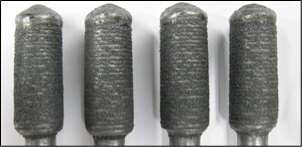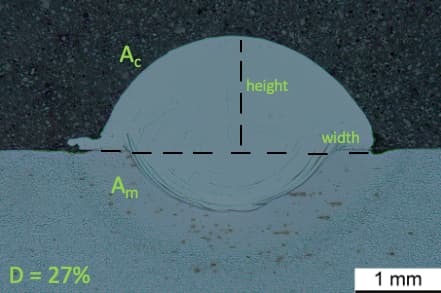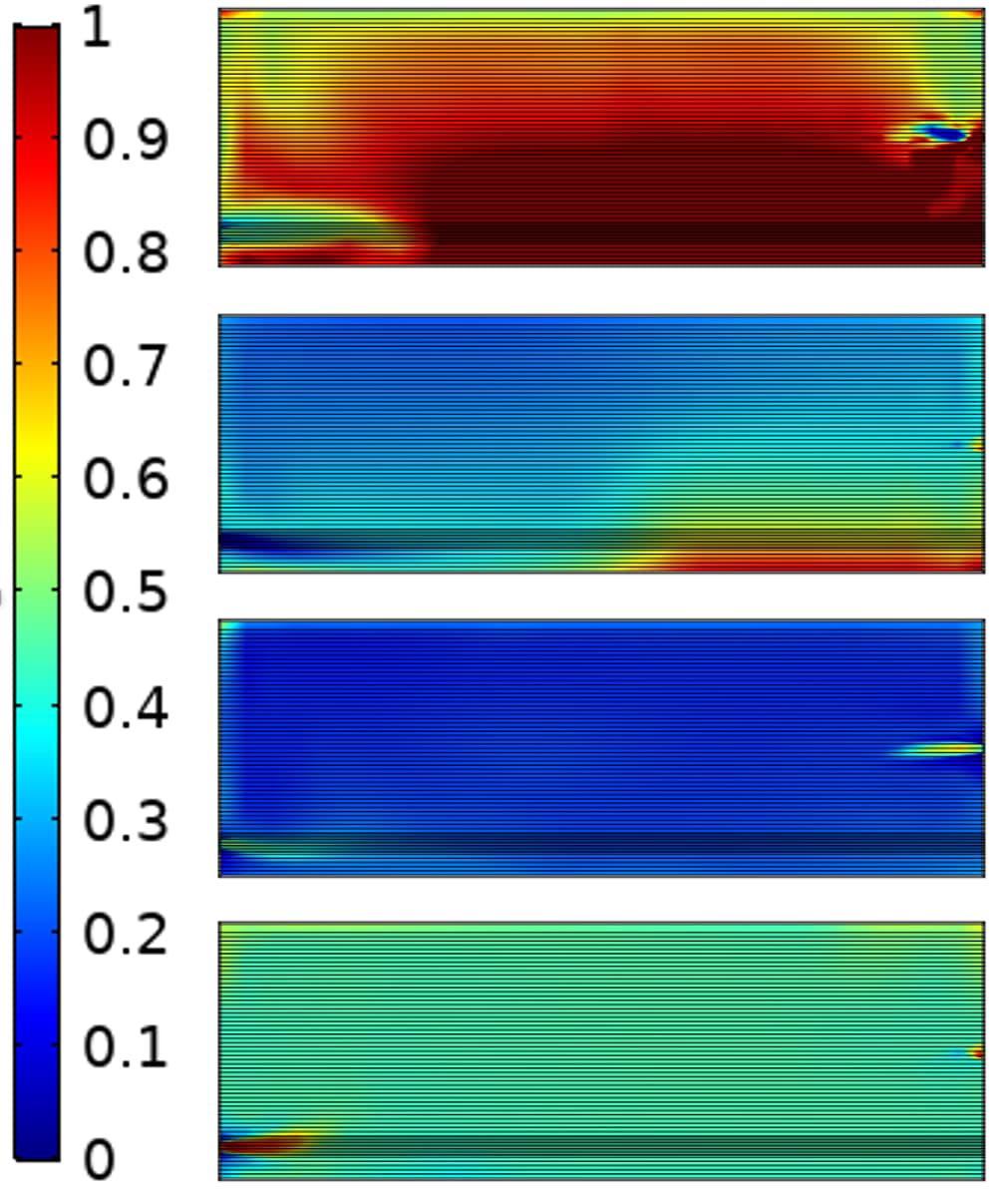Projects
DSI, Victoria University, and RMIT University
RMIT’s RDF Team has partnered with Victoria University’s A/Prof Daniel Lai & his Smart Electronic Systems research group with funding from the Defence Science Institute (DSI). The first project investigated the use of carbon quantum dots (CQDs) in flexible polymer substrates to develop stand-off strain sensors. Work is continuing to increase the quantum yield (brightness) of the dots, with the highlight being the environmentally sustainable fabrication of carbon dots from natural resources. The second project examined sustainably fabricating carbon quantum dots for the bio-imaging of cells. This resulted in some joint publications, e.g.: KK Anpalagan, JV Karakkat, A Truskewycz, A Al Saedi, P Joseph, V Apostolopoulos, K Nurgali, I Cole, Z Cai, and DTH Lai (2020). ‘Bioimaging of C2C12 muscle myoblasts using fluorescent carbon quantum dots synthesized from bread’, Nanomaterials, 10, 1575, DOI: 10.3390/nano10081575.
 Figure 1: Fluorescence images of C2C12 cells after 24 h of incubation with CQDs. (A,B) Cells incubated with water as control; (C,D) cells incubated CQD-A; (E,F) cells incubated with CQD-B; (A,C,E) are images from FITC (green) channel; (B,D,F) are images from TRITC (red) channel. This figure is reproduced from the above-cited open-access publication
Figure 1: Fluorescence images of C2C12 cells after 24 h of incubation with CQDs. (A,B) Cells incubated with water as control; (C,D) cells incubated CQD-A; (E,F) cells incubated with CQD-B; (A,C,E) are images from FITC (green) channel; (B,D,F) are images from TRITC (red) channel. This figure is reproduced from the above-cited open-access publication
ANCA Machine Tools, CSIRO, and RMIT University
Aaqil Sameem recently completed his research Masters thesis on ‘Cutting Tool Development Using a Novel Non-traditional Manufacturing Process’. This work was partly funded by CSIRO and the Melbourne-based company ANCA Machine Tools. The work highlighted that the laser-based additive & subtractive manufacturing process can be effectively used to manufacture metal-cutting tools. His work was mainly focused on tests & analyses of laser builds and some aspects of cutting performance tests. He also identified that a suitable postprocess heat treatment was also required for improvement of the cutting performance of additively built tools. His work was supervised by Dr Nazmul Alam (CSIRO) with co-supervision & support from Prof. Ivan Cole (RMIT University), Dr Xiao-Bo Chen, and their RDF research team.
 Figure 1: Laser-cladded cutting tools on a steel shank
Figure 1: Laser-cladded cutting tools on a steel shank
 Figure 2: Finished cutting tools after grinding to the desired geometry
Figure 2: Finished cutting tools after grinding to the desired geometry
SEAM ARC Training Centre
SEAM Centre homepage, SEAM Centre project list
- SEAM-RMIT project ‘Optimization of surface properties of additive components using an additive/subtractive machine’ ·
- Industry partner: Romar Engineering Pty Ltd
Metal additive manufacturing (AM) has many advantages including the ability to reproduce from CAD designs and develop complex structures as well as significant energy & material savings compared to traditional manufacturing. However, further improvements are possible, e.g. AM is relatively slow, can induce residual stresses in manufactured parts, may produce a rough surface finish requiring postprocess smoothing, and may needs high-quality/expensive powders. This project assesses whether a hybrid machine incorporating both AM & traditional subtractive manufacturing (SM) can reduce these issues.
This project will use the DMG Mori Lasertec 5-axis hybrid 3D printer, which has a 10 times faster deposition rate than other additive machines and can perform laser deposition AM & milling SM. The target is to use these capabilities to rapidly produce parts with low residual stress & smoother surface finish. This technology is initially targeted at the aerospace, defence, and biomedical sectors. This research is managed by RMIT’s Prof. Ivan Cole with industry partner Romar Engineering Pty Ltd, and includes:
- Using machine learning to determine build quality vs. online sensor data for various build parameters (postdoctoral fellow – Dr Rou Jun Toh)
 Figure 1: Cross section of a stainless steel 316L single track. Target features (dilution, width, height) were extracted from experimental studies and subsequently used in machine learning models.
Figure 1: Cross section of a stainless steel 316L single track. Target features (dilution, width, height) were extracted from experimental studies and subsequently used in machine learning models.
 Figure 2: Investigation of feature importance for (a) height & (b) dilution indicated that the laser scan rate plays the most significant role in tuning these target features.
Figure 2: Investigation of feature importance for (a) height & (b) dilution indicated that the laser scan rate plays the most significant role in tuning these target features.
- Visualisation of 3D printer online sensor data for offline quality control. Code was embedded into an open-source data visualisation software (ParaView) to provide an easy method for clients to visualise and report build statistics as a quality control & assurance tool. (Dr Rou Jun Toh, Dr Milan Patel, RMIT project students).

 Figure 4: 3D build reconstruction with data points (99th percentile) highlighted to supplement experimental work for defect detection
Figure 4: 3D build reconstruction with data points (99th percentile) highlighted to supplement experimental work for defect detection
- Surface properties of components formed by hybrid manufacturing (PhD – Ikram Ul Hassan)
- Multi-objective optimisation of AM components subject to multiphysics loading (PhD – Jim Jose)
BAE Systems (Australia)
- BAE Systems (Australia)-RMIT project on environmental sensing within unsensored bays of aircraft
Corrosion is a major contributing factor to aircraft structural failures. Corrosion monitoring is at the core of maintaining & perpetuating assets, particularly aircraft that experience highly variable environmental conditions. Large national defence forces & airlines therefore spend billions annually on corrosion monitoring & control [1]. Newer research in this area includes (i) conducting computational fluid dynamics (CFD) simulations to predict corrosion-inducing conditions within specific regions such as unpressurised bays where moisture & pollutants are likely to collect [2] (Figure 1), and (ii) use of a physical on-ground model that reproduces these processes for the CFD simulations to be verified against [3] (Figure 2). This lab model contained two enclosed spaces that were subject to simulated flight cycles, and in doing so, developed differences in RH, temperature, and pressure. The resulting heat flow, mass flow & rates of corrosion were then recorded. Here, the lab-based ‘flight tests’ were used to (i) calculate heat & mass transfer coefficients between the bulk airflow & metal surfaces of the chambers during ascent, cruising, descent, and parked conditions, and (ii) validate CFD simulations of the lab apparatus. The CFD simulations were then be repurposed to predict the corrosive microclimate within unpressurised bays during flight & storage. This project was part of the R&D phase of the Corrosion Prognostics & Health Management platform developed & supplied by BAE Systems (Australia) to optimise corrosion inspection scheduling by fleet managers.
[1] E Herzberg (2010). ‘Cost of Corrosion to DoD’, 2010 DoD Maintenance Symposium & Exhibition, 15-18 November 2010, Tampa Bay, Florida.
[2] MJ Patel & I Cole (2018). ‘Enhancing aircraft corrosion risk management via microclimate simulation’, Aircraft Airworthiness & Sustainment AA&S (Australia), 3-6 July 2018, Brisbane, Australia, link.
[3] M Patel, W Ganther, and I Cole (2020). ‘Use of real and mathematical models to predict aircraft corrosion in unpressurised bays’, EUROCORR 2020 virtual conference, 7th September 2020, link.
 Figure 1: Relative humidity distribution within a simplified unpressurised aircraft bay during ascent, cruising, descent, and storage
Figure 1: Relative humidity distribution within a simplified unpressurised aircraft bay during ascent, cruising, descent, and storage
● Ascent
○ Lower air cold/damp
○ A/C keeps front wall dry
○ ‘Strong’ asymmetry
● Cruising
○ Bay is much drier
○ Damp region near exit wall
● Descent
○ Rapid, chaotic mixing
○ Thus, RH is near uniform
● Parked
○ RH = uniform
○ RH = increases to RH ground
 Figure 2: Physical on-ground apparatus that reproduces on demand the environmental conditions experienced within unpressurised aircraft bays both in flight and on the ground. This apparatus provided experimental data that CFD simulations of unpressurised bays can be verified against.
Figure 2: Physical on-ground apparatus that reproduces on demand the environmental conditions experienced within unpressurised aircraft bays both in flight and on the ground. This apparatus provided experimental data that CFD simulations of unpressurised bays can be verified against.
Apparatus' enclosing boxes
- ‘Upper box’: replicate conditions in the pressurised bay of the aircraft
- ‘Upper cover box’: insulate upper box from environmental chamber condition
- ‘Lower box’: replicate conditions unpressurised bay of the aircraft
- ‘Lower cover box’: insulate lower box from environmental chamber condition
Environmental test chamber
(a) Instrumentation within (3)
(b) Instrumentation within (1)
(c) Instrumentation above (1)
CSIRO
The RDF Team collaborates with CSIRO across both metal fabrication & surface functionality. Areas of strategic partnership include metal fabrication for tool design & biomedical implant design (via additive, subtractive, and hybrid manufacturing) and modelling of complex materials (from the scale of individual chemical reactions to an entire manufacturing unit operation). Our research with CSIRO includes both experimental research & computational research (machine learning modelling & simulation modelling). This sustained partnership has allowed us to combine RMIT’s strengths as a leading research-intensive university for applied science & engineering with CSIRO’s cutting-edge research labs & connections to government & industry.
Project research student or postdoctoral fellow |
Project/thesis title |
Duration |
CSIRO contacts |
Dr Omid Bafkar (PhD) |
Study of Airflow Phenomena in the Human Respiratory System |
2017-2021 |
|
Dr Bin Qian (PhD) |
Development of Coumarins and their Composites as Optical Sensors for Cu2+ Contaminants in Water & Soil |
2017-2021 |
|
Dr Guang Zeng (PhD) |
Novel Fast Manufacturing Approaches for Biocompatible Structures |
2017-2021 |
|
Elias Salloum (PhD) |
Optimizing Friction Stir Welding and Aluminium Alloy Design to Ensure the Durability of Lightweight Carriages in the Rail Fleet Industry |
2018-2021 |
|
Jiajia Zhao (PhD) |
Catalyst Development for CO₂ Hydrogenation and Mechanism Study |
2018-current |
|
Dr Magdi Morks (PhD) |
Properties of Titanium Cold Spray Additive Components with Consideration of Post-Fabrication Treatment |
2018-2022 |
|
Jiayu Ye (PhD) |
In-situ Visual Monitoring of Laser Metal Deposition for Additive Manufacturing |
2019-current |
|
Neil Wilson (PhD) |
Conformal Tooling via Hybrid Manufacturing |
2019-current |
|
Aaqil Sameem (MRes) |
Cutting Tool Development using a Novel Non-Traditional Manufacturing Process |
2019-2022 |
|
Sun Yeang Chew (MRes-CSIRO/RMIT Masters) |
Exploratory Analysis of the Use of Simultaneous Localisation & Mapping (SLAM) during Cold Spray Additive Manufacturing |
2020-current |
|
Subash Gautam (PhD-CSIRO AIM FSP) |
Vision Systems for Process Control in Metal Additive Manufacturing |
2021-current |
|
Muhammad Azhar Shahzad (MRes-CSIRO/RMIT Masters) |
3D Transient Thermal Finite Element Modelling of AlSi10Mg Alloy to Develop Correlations Between Process Parameters & Microstructural Evolution |
2021-current |
|
Felix Nugraha Lomo (MRes-CSIRO/RMIT Masters) |
Towards Fabrication of Aerospace Components via Cold Spray Additive Manufacturing |
2021-current |
|
S. T. Tanushi De Silva (MRes-CSIRO/RMIT Masters) |
Role of Irregularly Shaped Powders in Powder Bed & Electron Beam Additive Manufacturing (EBAM) of Ti-Ta Structures for Biomedical Applications |
2021-current |
|
Sana Awan (PhD-CSIRO AIM FSP) |
Non-Destructive Defect Detection & Analysis for Additive Manufacturing of Metals |
2021-current |
|
Dr Milan Patel [main researcher Dr Patrick O’Toole (ex-CSIRO) & Dr Chao Tang (ex-NTU Singapore)] |
Multiscale Modelling of Selective Laser Melting |
2018-2021 |


